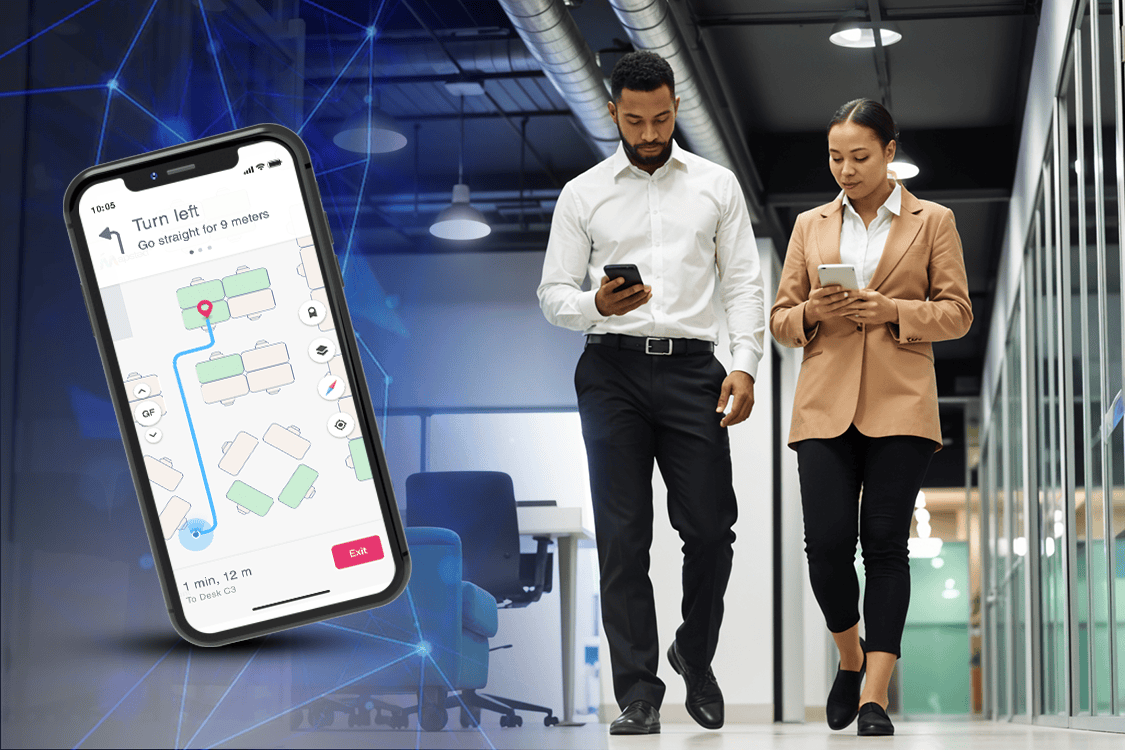Corporate Offices

Hybrid work is now the norm. According to JLL, 87% of organizations operate hybrid programs and goals tied to enhancing workplace experience have jumped 37% in recent years (CBRE). But adapting to this shift means more than just reducing headcounts. It’s about building intelligent, flexible environments where people and technology work in sync — and that’s exactly how location tracking is revolutionizing hybrid workplaces.
That’s where indoor location tracking steps in, not as a buzzword, but as a powerful, real-time enabler of smarter hybrid workplace solutions. By using Wi-Fi, sensors or mobile data to understand how space is used, companies are unlocking new ways to improve collaboration, efficiency and employee satisfaction. Here’s how this smart office technology is rewriting the rules of modern offices.
1. Making Hybrid Space Work Harder: Smarter Utilization Through Data
In hybrid workplaces, occupancy can vary wildly. Some days, desks are packed. Other days? Ghost town. Indoor location tracking offers a live look at these trends, showing exactly which rooms, desks and zones are in use, how often and when.


This allows office space management teams to:
- Reclaim underused areas (e.g., turning empty desks into lounges)
- Consolidate office space and reduce real estate costs
- Adjust HVAC or lighting based on live occupancy
A global JLL survey found that 79% of companies prioritize hybrid office space utilization, while 60% focus on improving employee experience. Location tracking delivers both by enabling dynamic layouts that reflect actual usage, not assumptions. It’s office space management backed by evidence, not guesswork.
“Utilization data has become the key to unlocking the value of hybrid work.” – JLL
2. Wayfinding and Workplace Navigation: Helping People Find People
For employees, hybrid work can feel disorienting, especially in large offices. Real-time location services in the workplace and workplace wayfinding solutions solve this with intuitive mobile maps that:
- Show your location with a familiar “blue dot.”
- Offer turn-by-turn directions to meeting rooms, desks or amenities
- Help locate colleagues or shared tools in real time
These features reduce downtime, confusion and frustration. Platforms like Avuity note that 20% of large companies now use or plan to use wayfinding technology. Because when workers only visit a few times a week, they often behave like visitors anelp navigating.
Bonus: These tools boost productivity by making the office easier to use. Employees spend less time searching and more time connecting.
3. Location Data for Smarter Space Management
Behind the scenes, indoor tracking empowers Corporate Real Estate teams to make surgical decisions. Instead of static floor plans, they now use live dashboards combining:
- Real-time occupancy
- Historical traffic patterns
- Predictive analytics
This helps answer key questions:
- Which zones are always underused?
- How does foot traffic shift across weekdays?
- Can we repurpose space to meet new team needs?
As per reports, 77% of companies were tracking utilization in 2023, up from 55% in 2018. And with hybrid work evolving, that data is now mission-critical. Facilities can dynamically adjust layouts, shut down unused zones for energy savings or reroute cleaning schedules to match real occupancy, all powered by location intelligence.
Integrated systems also unlock deeper automation. Think: syncing badge data with room booking and lighting systems to auto-release unused reservations or dim lights in empty areas. Even digital twins, real-time replicas of the office, are being built to simulate layout changes before they’re implemented.
4. Boosting Productivity and Satisfaction Through Location Sharing
The most immediate impact of location tools? Happier, more productive employees.
Employees can:
- Instantly find free rooms or desks
- Locate colleagues on-site with opt-in visibility
- Navigate unfamiliar spaces without asking around
This convenience reduces cognitive load and enables more spontaneous collaboration. It also improves employee morale by giving them more control over their day.
In a flexible culture, these small moments matter. When it’s easy to say, “Meet me here,” or grab a tool from the nearest space, employees feel more supported. That’s why 60% of hybrid-focused companies cite employee experience as a primary goal.
“The smarter, the more connected the workplace experience, the more impressed your users will be.” – CXApp
Indoor location sharing features (like “find a colleague” tools) are now standard in many workplace apps, helping employees see who’s in the office, where they’re seated and how to reach them without disruption.
5. The Road Ahead: AI, Privacy and Hardware-Free Innovation
Location tracking isn’t just evolving, it’s accelerating.
Emerging trends include:
- AI & behavioural insights: Tools like Microsoft Places are combining location data with calendars and smart suggestions (“Want to book a room next to your collaborator on Tuesday?”).
- Real-time automation: Smart buildings help facility managers plan energy usage based on live occupancy.
- Privacy-first architecture: Leading platforms anonymize data and offer opt-in location sharing, ensuring transparency and compliance with data regulations.
- Hardware-free systems: Companies like Mapsted are pioneering indoor location platforms that require no external hardware, making implementation easier and more scalable.
“Smart offices of the future will be flexible, privacy-respecting and adaptive by design.”
Conclusion
The hybrid office isn’t a trend, it’s the future. And indoor location tracking is proving essential to making it work.
From hybrid work environment optimization and smart office technology to happier employees who can navigate and collaborate with ease, the benefits are compelling. How location tracking is revolutionizing hybrid workplaces becomes evident as organizations harness real-time location services — gaining not just efficiency, but a competitive edge.
Mapsted offers scalable indoor location solutions that work without Wi-Fi or beacons, helping businesses future-proof their hybrid workplace solutions with minimal setup.
In a world where the office must adapt daily to who shows up, real-time awareness isn’t a luxury, it’s a necessity. If you found this blog helpful, don’t miss our blog post on How Employee Tracking System Boosts Workplace Productivity in 2025? or watch our video on Revolutionize Your Workplace with Mapsted Technology’s Inclusive Accessibility Features to learn more.
Frequently Asked Questions
Q: What is indoor location tracking and how does it work in a smart office?
A: Indoor location tracking uses technologies like Wi-Fi, sensors or mobile signals to pinpoint the real-time location of people and assets within a building. In smart offices, it supports navigation, occupancy monitoring and dynamic workspace management.
Q: How location tracking revolutionizing Hybrid workplaces?
A: By providing real-time insights into space usage, indoor tracking helps organizations adapt office layouts, reduce underused areas and align resources with employee attendance patterns, making hybrid workspaces more efficient and agile.
Q: Is indoor location tracking a privacy concern for employees?
A: Modern indoor tracking platforms, including Mapsted’s, use privacy-forward practices like anonymization and opt-in sharing. These tools are built to respect employee privacy while still delivering actionable workspace insights.
Q: How does indoor location sharing improve collaboration in hybrid workplaces?
A: Location sharing features let employees see where colleagues are seated and which resources are available, reducing friction and enabling spontaneous, in-person collaboration even in flexible work settings.
Q: Can existing office buildings be retrofitted with indoor location tracking?
A: Yes. Hardware-free solutions like Mapsted’s don’t require external infrastructure like beacons, making it easy and cost-effective to implement tracking in older or mixed-use buildings.

